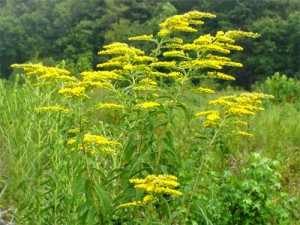Putting the garden to bed with nature

goldenrod Goldenrod flower stems produce fluffy seed heads that provide food for birds and winter interest in gardens and fields. Photo by Ken Moore.
By Ken Moore
The “fall is for planting†counterpart to the spring gardening frenzy is in full swing. While I marvel at the energy of gardeners planting, pruning, cleaning and “putting gardens to bed for the winter,†I just can’t bring myself to direct energy on any of these activities. I’m way too absorbed trying to keep pace with nature’s gardens peaking everywhere just now.
For me, the notion of “putting the garden to bed for the winter†has a sinister tone of finality about it. Though many plants take a so-called rest, the garden doesn’t stop in the winter.
Observing nature, you’ll note that some plants send up their leaves in the fall to take advantage of the winter sunlight. For many plants, the winter months are the true growing season.
Take special care of perennials with evergreen foliage or newly emerging green basal rosettes, like the hummingbird’s favorite cardinal flower. If you put those plants to bed with a blanket of mulch, you’ll lose them.
If you plan to cut down all those dried stems and fluffy seed heads, take another hint from nature’s wild gardens: tall branching stems and variously shaped capsules and fluffy seed heads remain standing to provide food and shelter for birds and other critters. In addition, the standing stems provide winter beauty with the play of sunlight and the capturing of dew and raindrops and, on rare occasions, snow and ice. Consider leaving a few of those seed heads and stems for the birds and added points of interest in your own garden.
Over the years, I’ve discovered nature to be a helpful gardening partner. Many of my original plants just couldn’t make it without excessive watering and other care. I simply could not water enough my favorite clump of Joe-Pye weed.
Fortunately, nature moved it by seed to other locations where they thrive without any help from me.
Nature also took charge of the design around my hot west-facing deck. The colorful perennial border along the edge slowly succumbed to the root and shade competition of a southern sugar maple that volunteered there. The shade of that tree now makes the deck habitable in the summer. I love that tree more than the original flower border.
As in nature’s gardens, each year I look forward to a different garden design around my house. I never know where the passion flower will emerge. I have to be vigilant to spot where the annual wild jimson weed will occur. Perennial poke, another favorite, is more predictable, but there are always new ones I select to leave here and there to replace old ones.
I’m always on the lookout for volunteer redbuds, dogwoods, black haws, sumacs and deciduous hollies. Selecting a few to leave in place ensures me truly maintenance-free specimen plants.

Swamp sunflower, coreopsis and boneset dominate the current spectacular fall wildflower display in the coastal plain habitat of the N.C. Botanical Garden. Photo by Ken Moore.
Letting nature become an active partner in planting and thereby influence the design of the ornamental garden has reduced my responsibilities to occasional pruning and weeding, leaving more time for the vegetable garden.
Whether or not you choose to partner with nature as you garden, take time out to enjoy nature’s gardens all along our country roadsides. A must-see natural garden is the coastal plain habitat at the N.C. Botanical Garden. It is unbelievable. At an all-time peak right now, the sculptural and color effects of the wildflowers rival the annual sculpture show outside and the paintings of Robert Johnson and botanical illustrators inside.


Comments are closed.